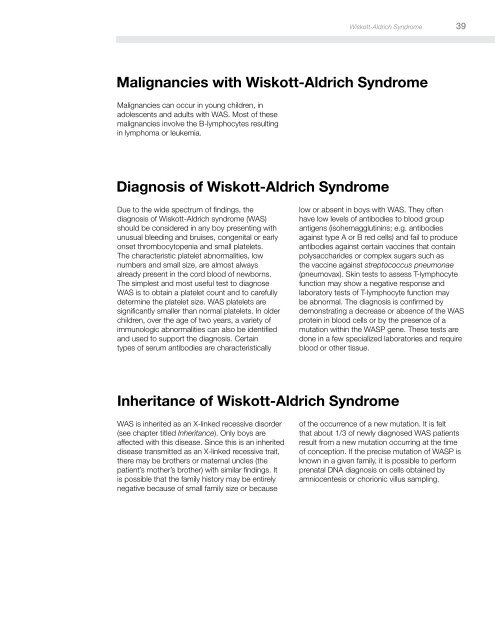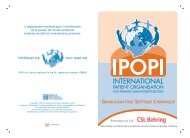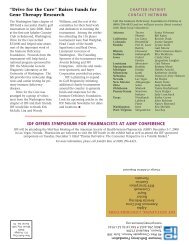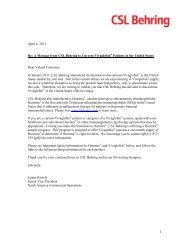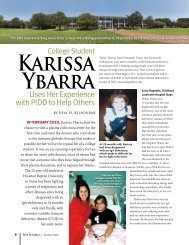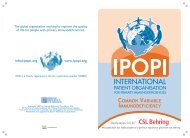IDF Patient & Family Handbook for Primary Immunodeficiency ... - IDFA
IDF Patient & Family Handbook for Primary Immunodeficiency ... - IDFA
IDF Patient & Family Handbook for Primary Immunodeficiency ... - IDFA
Create successful ePaper yourself
Turn your PDF publications into a flip-book with our unique Google optimized e-Paper software.
Wiskott-Aldrich Syndrome 39<br />
Malignancies with Wiskott-Aldrich Syndrome<br />
Malignancies can occur in young children, in<br />
adolescents and adults with WAS. Most of these<br />
malignancies involve the B-lymphocytes resulting<br />
in lymphoma or leukemia.<br />
Diagnosis of Wiskott-Aldrich Syndrome<br />
Due to the wide spectrum of findings, the<br />
diagnosis of Wiskott-Aldrich syndrome (WAS)<br />
should be considered in any boy presenting with<br />
unusual bleeding and bruises, congenital or early<br />
onset thrombocytopenia and small platelets.<br />
The characteristic platelet abnormalities, low<br />
numbers and small size, are almost always<br />
already present in the cord blood of newborns.<br />
The simplest and most useful test to diagnose<br />
WAS is to obtain a platelet count and to carefully<br />
determine the platelet size. WAS platelets are<br />
significantly smaller than normal platelets. In older<br />
children, over the age of two years, a variety of<br />
immunologic abnormalities can also be identified<br />
and used to support the diagnosis. Certain<br />
types of serum antibodies are characteristically<br />
low or absent in boys with WAS. They often<br />
have low levels of antibodies to blood group<br />
antigens (isohemagglutinins; e.g. antibodies<br />
against type A or B red cells) and fail to produce<br />
antibodies against certain vaccines that contain<br />
polysaccharides or complex sugars such as<br />
the vaccine against streptococcus pneumonae<br />
(pneumovax). Skin tests to assess T-lymphocyte<br />
function may show a negative response and<br />
laboratory tests of T-lymphocyte function may<br />
be abnormal. The diagnosis is confirmed by<br />
demonstrating a decrease or absence of the WAS<br />
protein in blood cells or by the presence of a<br />
mutation within the WASP gene. These tests are<br />
done in a few specialized laboratories and require<br />
blood or other tissue.<br />
Inheritance of Wiskott-Aldrich Syndrome<br />
WAS is inherited as an X-linked recessive disorder<br />
(see chapter titled Inheritance). Only boys are<br />
affected with this disease. Since this is an inherited<br />
disease transmitted as an X-linked recessive trait,<br />
there may be brothers or maternal uncles (the<br />
patient’s mother’s brother) with similar findings. It<br />
is possible that the family history may be entirely<br />
negative because of small family size or because<br />
of the occurrence of a new mutation. It is felt<br />
that about 1/3 of newly diagnosed WAS patients<br />
result from a new mutation occurring at the time<br />
of conception. If the precise mutation of WASP is<br />
known in a given family, it is possible to per<strong>for</strong>m<br />
prenatal DNA diagnosis on cells obtained by<br />
amniocentesis or chorionic villus sampling.


